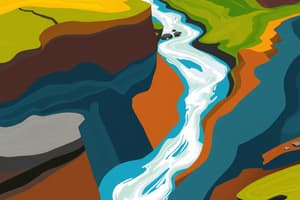Podcast
Questions and Answers
What is the base level of a stream?
What is the base level of a stream?
- The point where stream channel erosion does not occur (correct)
- The lowest point in the stream where water cannot flow
- The highest point in the stream
- The point with the fastest water flow in the stream
What is the velocity of a stream?
What is the velocity of a stream?
- The speed at which water flows through a stream channel (correct)
- The depth of the stream
- The temperature of the water in the stream
- The width of the stream
Why does the velocity of water decrease along the stream bed and banks?
Why does the velocity of water decrease along the stream bed and banks?
- As a result of decreased friction exerted by the landmass on water
- Due to an increase in energy
- Increased depth of the stream
- Because of larger rocks obstructing the flow (correct)
How does the power of running water to erode the channel change with decreasing velocity?
How does the power of running water to erode the channel change with decreasing velocity?
What are the two types of base levels in a stream?
What are the two types of base levels in a stream?
Why does water flow with less energy at the base level of a stream?
Why does water flow with less energy at the base level of a stream?
What hinders the flow of water in a stream at the base level?
What hinders the flow of water in a stream at the base level?
What is the ultimate base level in terms of stream erosion?
What is the ultimate base level in terms of stream erosion?
What describes the local base level's impact on stream erosion?
What describes the local base level's impact on stream erosion?
What effect does high velocity water flow have on stream channel erosion?
What effect does high velocity water flow have on stream channel erosion?
Which scenario would likely lead to more sediment deposition on a stream bed?
Which scenario would likely lead to more sediment deposition on a stream bed?
How do dams influence sediment deposition in streams?
How do dams influence sediment deposition in streams?
Which of the following is NOT an example of a local base level?
Which of the following is NOT an example of a local base level?
How does lowering the base level affect stream erosion?
How does lowering the base level affect stream erosion?
Why does still or calm water at a base level result in lesser channel erosion?
Why does still or calm water at a base level result in lesser channel erosion?
Flashcards are hidden until you start studying
Study Notes
Base Level of a Stream
- The base level of a stream is the lowest point to which the running water can flow or a channel can erode.
- Stream channel erosion does not occur below the base level.
Velocity of Stream Water
- The velocity of stream water is the speed at which water flows through a stream channel.
- It is measured in feet per second (ft/s) or meters per second (m/s).
- Water flows with the greatest velocity and has high energy near the surface in midstream.
- Velocity decreases along the stream bed and banks due to friction.
- Velocity shares direct proportionality with the energy of the water flow.
Types of Base Level
- There are two types of base levels: the ultimate base level and the local base level.
- The ultimate base level is the sea level, which is the height or altitude of the ocean's surface.
- The local base level is the lowest level where the stream water gets stalled or stuck for a period of time.
Base Level Effects
- The velocity of running water and its power to erode the stream bed share direct proportionality.
- High velocity and greater energy cause erosion of the stream channel by carrying away sediments.
- Less velocity and diminished energy lead to deposition of sediments.
- Still or calm water does not cause erosion of the stream bed.
Examples of Base Level
- The ocean is the ultimate base level.
- A lake, a dam, and a waterfall are examples of local base levels.
- A lake becomes the temporary base level when a stream drains into it.
- A dam is constructed to hinder the natural flow of water, causing deposition of sediments within the reservoir.
Studying That Suits You
Use AI to generate personalized quizzes and flashcards to suit your learning preferences.




